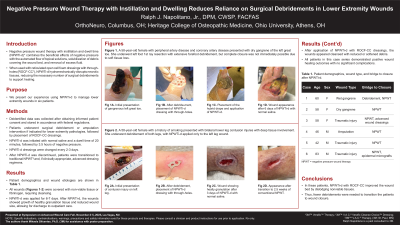Case Series/Study
(CS-106) Negative Pressure Wound Therapy with Instillation and Dwelling Reduces Reliance on Surgical Debridements in Lower Extremity Wounds

Introduction: Negative pressure wound therapy with instillation and dwell time (NPWTi-d)* combines the beneficial effects of negative pressure with the automated flow of topical solutions, solubilization of debris covering the wound bed, and removal of excess fluid. When used with reticulated open cell foam dressings with through-holes (ROCF-CC†), NPWTi-d hydromechanically disrupts necrotic tissues, reducing the necessary number of surgical debridements to support healing.
Methods: Deidentified data was collected after obtaining informed patient consent and stored in accordance with federal regulations. Patients underwent surgical debridement or amputation intervention if indicated for lower extremity pathologies, followed by placement of ROCF-CC dressings. NPWTi-d was initiated with normal saline and a dwell time of 20 minutes, followed by 3.5 hours of negative pressure. NPWTi-d dressings were changed every 2-3 days. After NPWTi-d was discontinued, patients were transitioned to traditional NPWT and, if clinically appropriate, advanced dressing regimens.
Results: The patients were 3 males and 3 females, aged 42 to 83 years old. Wound etiologies included traumatic injury, gangrene, and diabetic foot infection requiring amputation. After application of NPWTi-d with ROCF-CC dressings, the wounds appeared cleansed with reduced or softened debris. All patients in this case series demonstrated positive wound healing outcomes with no significant complications.
Discussion: In these patients, NPWTi-d with ROCF-CC improved the wound bed by dislodging nonviable tissues. Thus, fewer debridements were needed to transition the patients to wound closure.
Trademarked Items: *3M™ Veraflo™ Therapy, †3M™ V.A.C. Veraflo Cleanse Choice™ Dressing (3M, St. Paul, MN)
References:
Methods: Deidentified data was collected after obtaining informed patient consent and stored in accordance with federal regulations. Patients underwent surgical debridement or amputation intervention if indicated for lower extremity pathologies, followed by placement of ROCF-CC dressings. NPWTi-d was initiated with normal saline and a dwell time of 20 minutes, followed by 3.5 hours of negative pressure. NPWTi-d dressings were changed every 2-3 days. After NPWTi-d was discontinued, patients were transitioned to traditional NPWT and, if clinically appropriate, advanced dressing regimens.
Results: The patients were 3 males and 3 females, aged 42 to 83 years old. Wound etiologies included traumatic injury, gangrene, and diabetic foot infection requiring amputation. After application of NPWTi-d with ROCF-CC dressings, the wounds appeared cleansed with reduced or softened debris. All patients in this case series demonstrated positive wound healing outcomes with no significant complications.
Discussion: In these patients, NPWTi-d with ROCF-CC improved the wound bed by dislodging nonviable tissues. Thus, fewer debridements were needed to transition the patients to wound closure.
Trademarked Items: *3M™ Veraflo™ Therapy, †3M™ V.A.C. Veraflo Cleanse Choice™ Dressing (3M, St. Paul, MN)
References:

.png)
